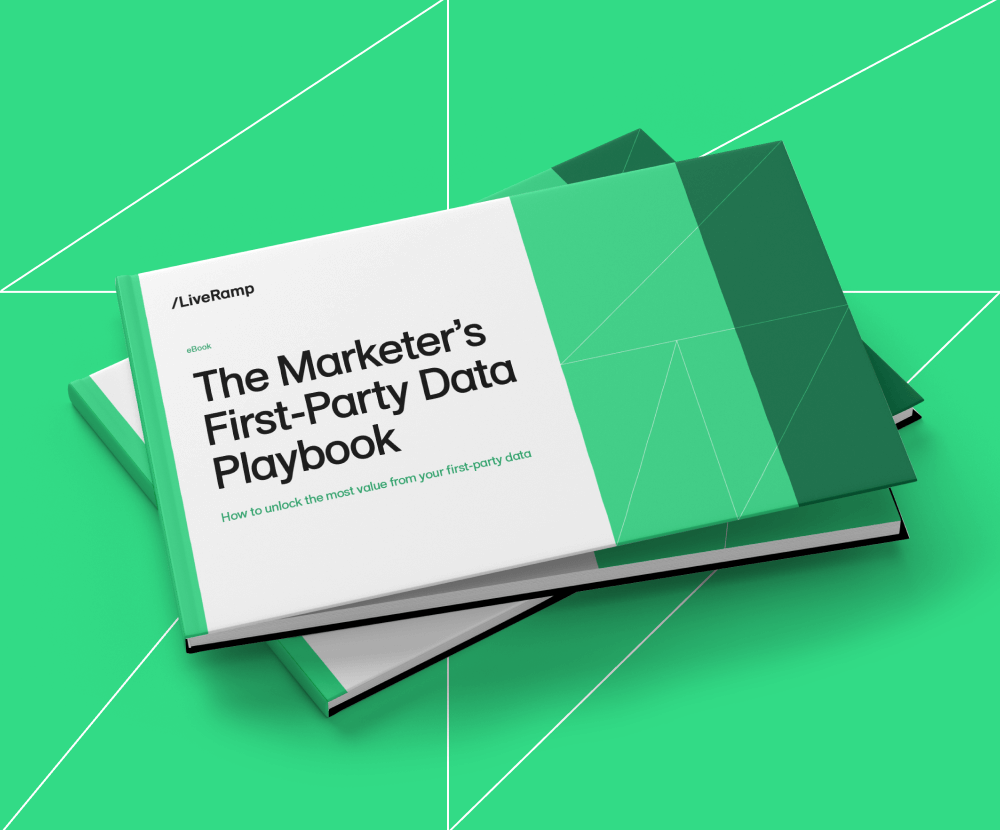Brands know interactions that feel personal and relevant to customers are key to driving conversions in our oversaturated digital environment. However, as signal loss continues, brands face significant challenges in maintaining effective reach, targeting, and measurement in their marketing efforts. Now is the time to get your first-party data strategies in order.
Without the signals third-party cookies send, it’s harder for companies to understand how customers interact with their brands across the digital ecosystem and owned channels. Specifically, charting customer journeys beyond the original touch point – for example, an email nurture campaign – becomes more difficult. As time goes on, the signal grows faint, meaning brands urgently need to adopt more robust mechanisms for reaching and engaging customers.
Enter identity resolution.
Identity resolution is the ability to accurately resolve consumer data from a variety of sources to a household or an individual in a privacy-centric manner. Identity should be the foundation of everything you do across your enterprise. As third-party signals fade, a robust identity strategy enables precise and personalized customer interactions, ensuring your marketing efforts build brand loyalty and drive conversions.
What is identity resolution?
Identity resolution is the process of connecting the dots between consumers’ digital footprints to give the full picture of their online behavior across devices, channels, and touchpoints. It’s a key component of effective data collaboration, promoting consistency and accuracy across multiple platforms and partners.
Identity resolution uses advanced algorithms and machine learning techniques to accurately link disparate pieces of data to the correct individual and create a comprehensive picture of a user’s interactions and behaviors across various platforms. By resolving identities across channels and devices, it becomes possible to recognize customers any time they interact with your brand. This helps to prevent signal loss so you can continue to tailor campaigns to customers’ behaviors, preferences, and interests without using third-party cookies.
How does identity resolution work?
Identity resolution works by combining data management strategies and advanced analytics to prevent signal loss and establish consistent identifiers across customer journeys.
Key elements of identity resolution include:
- Pseudonymous data
- Offline data
- Resolution
- Deterministic match
- Probabilistic match
1. Pseudonymous data
Pseudonymous data includes data points that don’t directly identify an individual, but that can be used to gain a sense of a person’s online activities and preferences. For example, a Mobile Ad ID (MAID) is a unique identifier created by a mobile device’s operating system and shared with apps downloaded to the device. A MAID can be used to “remember” an individual’s behavior and choices without using their personally identifiable data (PII). Identity resolution collects and connects these pseudonymous datasets, then resolves them down to an individual entity.
2. Offline data
Offline data comprises PII, such as an individual’s name, postal address, email address, and telephone number. This data is compiled over time through continuous customer interactions and stored in an offline reference graph.
3. Resolution
The resolution process uses advanced algorithms and matching logic to accurately link these disparate data sources to create consistent identities. Resolution can be done at either the individual or household level depending on what makes sense for your purposes. In both cases, resolving identities enables you to personalize customer experiences across channels and interaction points.
4. Deterministic match
Deterministic matching links different identifiers together. For example, when someone starts a new job, deterministic matching can link their new work email with accounts and activity associated with their old one. For the most accurate match and widest reach, this step should use a third-party offline reference graph.
5. Probabilistic match
Probabilistic identity methodologies complement deterministic matching to create a fuller picture of online identity. Devices can be implicitly grouped by data points such as IP address, operating system, Wi-Fi network, and location. Probabilistic matching uses statistical modeling to understand these groupings and assign them to identities at varying confidence levels.
Use cases for identity resolution
At LiveRamp, we use identity resolution in a variety of ways to help clients create unified, connected customer views:
1. Enterprise identity
Enterprise identity involves resolving digital data within your enterprise’s own four walls. LiveRamp uses identity resolution logic and algorithms to match and resolve your first-party customer and prospect data. This can include transaction, CRM, and CDP data, as well as information from call center inquiries and live chats. Enterprise identity is most often used to help business intelligence and analytics teams gain a 360-degree customer view to evaluate metrics like cost of acquisition, churn risk, lifetime value, and other KPIs.
With enterprise identity, we enable you to customize identity rules, infrastructure, and identifiers to align with your business priorities. By leveraging our offline identity graph, we can provide a high degree of accuracy in identifying and linking the same user across multiple devices and platforms – without needing to invest extensive resources in building your own. At the same time, identity is protected and your identity framework is consistent and clear so you get the most accurate and connected customer view possible.
2. RampID
Building an effective, engaging modern customer experience requires data connectivity: the linking of disparate datasets across ecosystems and identity environments. By breaking down silos and enabling collaboration, data connectivity enables you to activate data across all relevant touchpoints, making every customer interaction relevant and personalized.
RampID is an important part of the data connectivity story. LiveRamp’s durable, responsible identifier enhances addressability so you can maximize your marketing impact. As a result, you can reach audiences at scale anywhere in the world to deliver personalized experiences across browsers, mobile devices, CTV, and anywhere else they spend time.
LiveRamp uses RampIDs to help you deliver more relevant content to your customers and eliminate digital echo chambers of repetitive ads and irrelevant messaging. For example, it doesn’t make sense to show plane ticket offers to a customer after they’ve already booked a flight. In fact, it breeds frustration for customers who already paid full price and now can’t use the deal. RampID eliminates this friction by enabling you to deliver the right messages at the right times, creating a cohesive customer experience for customers across channels.
3. Data clean rooms
Data collaboration across ecosystems and systems fuels insight-driven innovation, but it introduces data leakage and compliance risks for your organization without the right infrastructure and technology in place. The LiveRamp data clean room offers advanced controls and permissioning, along with cutting-edge privacy-enhancing technologies, so you can safely unlock the powerful measurement tools and analytics you need to drive meaningful business outcomes.
One key use case for data clean rooms is identity translation: the process of translating identifiers across different identity environments. Identity resolution helps you generate stronger ROI from your clean room investments by enabling the most accurate possible overlapping and matching of datasets from multiple platforms and partners – and configuring privacy features in a way that doesn’t compromise individual identity.
Challenges with enabling data resolution today
Increased consumer demand for online privacy protections and more robust regulations are changing the ways brands can access, use, and share customer data. As a result, traditional data signals like third-party cookies are fading.
With signal loss, connecting and analyzing data across the digital ecosystem is more complex than ever. You need a partner who can connect and translate any combination of digital identifiers at scale to bridge the gaps between various channels and publishers, enabling cross-screen and cross-media measurement. Remember that Firefox and Safari/iOS eliminated cookies years ago. Without a durable, responsible identifier, your customer signals will continue to deprecate, and you won’t be able to take immediate action on the powerful insights you generate from data collaboration.
How LiveRamp’s identity solutions can help
To deliver personalized campaigns at scale, you need the most accurate, connected view of your customers built on well-defined identity rules that are applied consistently across every consumer interaction and collaborative partnership. These identity rules should be customized to your business’ needs to align with your specific operational goals and customer engagement strategies.
LiveRamp’s identity solutions create a holistic, connected view of customer data across your enterprise and the entire ecosystem so you can avoid signal loss and keep up with consumer demand. We power addressability across the entire digital ecosystem so you can engage customers where it matters most.
Contact us to learn how our identity resolution expertise can fuel your business goals.
Frequently asked questions about identity resolution
What are identity graphs?
An identity graph is a data structure that maps relationships between various identifiers and links them to a single individual or household. It provides a detailed, unified view of customer interactions across multiple touchpoints.
What is the role of identity resolution in identity graphs?
The role of identity resolution within identity graphs is to accurately and continuously update the connections between these identifiers. For example, when a customer logs in on a new device or updates their contact information, identity resolution ensures that these new data points are matched to the existing customer profile, so the identity graph remains consistent and reliable.
How does identity resolution improve cross-media marketing?
By linking customer data across different channels – websites, apps, email, and in-store visits – identity resolution helps brands create a unified customer profile. This enables marketers to deliver consistent messaging, personalized offers, and relevant experiences.
Can identity resolution work for both B2B and B2C brands?
Identity resolution works for both B2B and B2C brands. For B2C, it connects individual consumer data across touchpoints like websites, apps, and purchases to create personalized experiences. For B2B, it links company and decision-maker data, helping brands tailor messaging and improve account-based marketing. While the data and approach differ, the goal is the same: to create unified, actionable customer profiles.
How does identity resolution support customer retention?
By creating accurate, comprehensive customer profiles, identity resolution enables brands to better understand their needs, preferences, and behaviors. This insight allows for personalized offers and engagement strategies that drive loyalty and increase satisfaction, ultimately improving customer retention.
Why is now the right time for brands to adopt identity resolution?
With the decline of third-party cookies and the increasing demand for responsible data practices, now is the perfect time for brands to adopt identity resolution. It empowers businesses to maintain effective, personalized marketing strategies responsibly while dealing with signal loss. By embracing identity resolution, brands can maintain effective marketing efforts and meet changing consumer needs.




